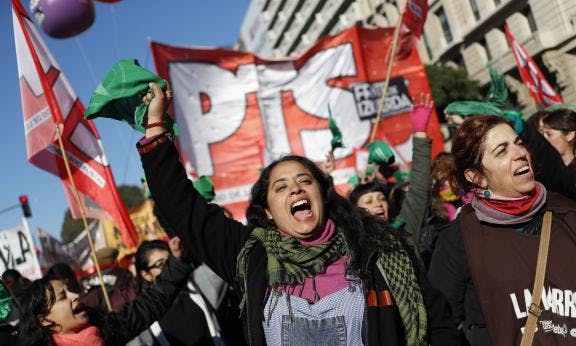Argentina rocked by general strike

Argentina ground to a halt on 24 and 25 September under the weight of a massive general strike. Concurrent national stoppages were called by the nation’s union movement in protest at the falling value of the Argentine peso, spiralling inflation and government austerity, all of which are being encouraged by the International Monetary Fund.
The general strike began with a 36-hour stoppage called by the Argentine Workers’ Central Union (CTA), beginning at midday on 24 September. Workers held spirited demonstrations across the country that afternoon.
Then, at the stroke of midnight, the General Confederation of Labour (CGT) began its own 24-hour general strike, but refused to organise any rallies or demonstrations for the following day. Nevertheless, by morning the country’s train, bus and underground stations were closed, most airline flights had been cancelled, public school classes were suspended, and public hospitals were operating with only minimal staff.
Argentina’s sizeable layer of anti-bureaucratic union groups, militant union branches and combative unions, known as sindicalismo combativo (militant unionism), along with the far left, mobilised independently of the CGT and CTA.
Dominated by various organisations of the Trotskyist left, these forces held their own combined rallies on 24 September before joining the CTA demonstrations later that afternoon. From 6am on 25 September, militants established roadblocks of highways and bridges across Buenos Aires and other major cities. In the capital, targeted sites included the Pan-American and 197 Highway intersection, in the city’s northern industrial area, and the symbolic Pueyrredón Bridge in the city’s south, where a similar protest in June 2002 ended in the police murder of piquetero (picketer) activists Maximiliano Kosteki and Darío Santillán.
The general strike was fuelled by Argentina’s rapidly deteriorating economic situation, which has been intensifying since early May. The central bank tried to rein in inflation by hiking interest rates to a staggering 40 percent (they have since hit 60 percent). But the interest rate rise only sent the Argentine peso into free fall. President Macri then approached the IMF for an initial US$30 billion loan to help stabilise the peso. But news of Argentina’s new IMF loan weakened the peso further, and its fall continued unabated.
By June, the government had agreed to an IMF loan of US$50 billion. But the usual IMF conditions meant that the government was obliged to “readjust” the budget, which in this case means reducing the budget deficit from 1.3 percent of GDP to zero in 2019. In 2020, the government must ensure the budget is in surplus equivalent to 1 percent of GDP. The burden of these budget cuts will be shouldered by workers.
Argentinian workers have suffered enough already. In the four months from May, the value of the Argentine peso to the US dollar has halved and inflation has risen to over 40 percent per annum. Unemployment is now approaching double digits, its highest level in over a decade. This year jobs are being lost at an average rate of 4,300 a month. Over 25 percent of the population now live below the poverty line.
The deteriorating economy has triggered an upturn in industrial activity. Teachers held a series of 24, 48 and 72-hour strikes, maritime unions held a 24-hour national stoppage on 24 May, a joint CTA, teachers’ and truck drivers’ strike took place on 14 June, and the CGT and CTA organised a joint 24-hour general strike on 25 June (the third since Macri took office in December 2015).
All of these strikes and demonstrations had the same basic demands: pay rises that keep pace with inflation, no more job losses and an end to government austerity and its accord with the IMF.
Workplaces threatened with job losses and closures have also fought back. These include the Astillero Rio Santiago shipyard, one of the few enterprises that staved off the wave of privatisation unleashed under Carlos Menem in the 1990s. Shipyard workers and their supporters have demonstrated, occupied Ministry of Economics buildings and even organised a “national day of struggle” on 12 September involving rallies and roadblocks across the country.
Other social mobilisations have included million-strong demonstrations to legalise abortion in mid-June and August, and enormous rallies in defence of public education in late August.
Industrial struggle and social mobilisations are not the only activity in response to the crisis. Harassment of union activists and the left is also on the rise. Last month, a teacher from the outskirts of Buenos Aires who gave free school meals to local children was kidnapped, and had the words “no more pots” carved into her stomach with a sharp object before being released.
Just days before the September general strike, Nicolás del Caño and Myriam Bregman, the former presidential and vice-presidential candidates for the Left Front Trotskyist electoral coalition, received hundreds of death threats on their mobile phones. These threats included pictures of General Videla, the dictator who led the military coup in 1976 and was responsible for the deaths of 30,000 people.
The centre right government of Mauricio Macri is becoming increasingly discredited as the economic situation continues to deteriorate. Industrial militancy and social mobilisation may be gaining momentum, but most workers in Argentina still have illusions in Peronism, particularly the “leftist” variety associated with former President Christina Kirchner. The CGT and CTA union federations are still controlled by Peronist bureaucracies.
These “opposition” forces, which have continually voted for austerity, now argue that the only solution is to vote for them at next year’s national elections.
Only time will tell if workers succumb to the siren song of this “opposition”, or reject it in favour of continued industrial and political struggle against IMF and government austerity.